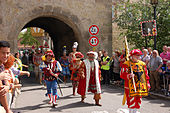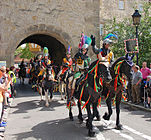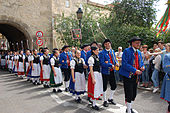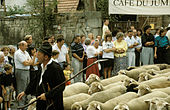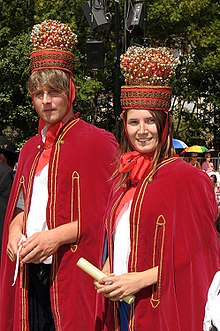Schäferlauf
The Schäferlauf is a Württemberg's festival with a long tradition that when fair originally on the consecration of the church of St. Bartholomew in the former Grüningen (now Markgröningen ) moved and later as a guild hard the sheep placed at the center. “Branch festivals” have also been held in Bad Urach and Wildberg since 1723 .
history


Legends of the faithful Barthel
The legend celebrated every year at the festival traces the origin of the Schäferlauf to a shepherd named "Barthel". He had resisted the unfaithful bailiff and his cronies, was then slandered by them and tempted by the camouflaged Count von Grüningen for a trial. Because he had shown himself to be extremely loyal to the count, however, he decided that from now on, “a great shepherd festival ” should be celebrated in honor of the “loyal Barthel” every year on his name day . According to another legend, the "loyal Barthel" is said to have helped the Count of Württemberg, who was besieged on the Hohenasperg, to escape via a secret passage in the direction of Grüningen.
Bartholomäus: patron of the city church and the shepherd
The Schäferlauf has its origins in the early Middle Ages as a parish festival of the St. Bartholomew's Church, which, according to tradition, was founded by Queen Hildegard († 783) and an associated big fair on August 24th, Bartholomew's Day . Because this apostle was also the patron saint of the shepherds and since the driving of the sheep across the fields was only possible at this time of the year after the "fruit" (grain harvest) had been brought in, it made sense to take part in the annual guild meeting of the shepherds, who migrate seasonally with their herds the once nationally "Barthelmarkt" significant in Grüningen merge. This merger could be done in the 14th century, when in the county Württemberg professional sheep was established. This is demonstrated for Markgröningen since 1396th
A first written reference to the festival dates back to 1445: A brother of the Grüninger Heilig-Geist-Spital noted in his list of expenses what he had bought at the Bartholomäusmarkt. According to Hans Grüninger (1527), as many visitors came to this annual and cattle market during the heyday of the residence and official city as to the Frankfurt trade fair. The " Barthelmarkt " in Oberstimm or the Bartlmädult in Landshut are of similar origin .
The first explicit mention as "Schäferlauf" with "Schäfertanz" comes from the year 1593 by the chronicler Jakob Frischlin , who in 1599 again described the "old custom", the pagan and voluptuous festival and the race over the stubble field in lyrical form : "[...] according to when this Dantz passed, the shepherds begin to undress up to Hemmet, it would often make a big laugh out of it [...], through Stupflen Feld with bare feet, every Schäffer has to run." Shepherd dance, like the “ mutton dance ” elsewhere, could actually have its roots in an ancient pagan custom that was ultimately linked to the parish fair, as in Onolzheim and other Franconian places.
In his portrait of the city of Gröningen, published in 1791 in the Geographical Statistical-Topographical Lexicon of Swabia , the pastor and historian Philipp Röder described the Schäferlauf in detail, albeit not without properly distancing himself from the extravagant celebrations of the "rabble" and the frivolity of the "women".
Guild rules and division
The Schäferlauf has been taking place in its current form since 1651. The Württemberg Duke Eberhard III. issued the shepherd's guild regulations, which regulated the tasks and the course of the meeting and the festival. Legal and regulatory matters of the shepherd's guild were negotiated at the meetings, and attendance was compulsory. Since the shepherds living all over the country sometimes had problems to get together at this annual guild meeting on August 24th, Duke Eberhard Ludwig had the main drawer split up in 1723 and side shops (quarter shops) set up in Heidenheim , Bad Urach and Wildberg . Annual guild meetings were now also held in these cities. The shepherds from the Württemberg offices (from 1758 Oberämter) Backnang, Besigheim, Böblingen, Brackenheim, Cannstatt, Leonberg, Ludwigsburg, Marbach, Maulbronn, Neckarsulm, Schorndorf, Stuttgart, Vaihingen an der Enz, Waiblingen and Weinsberg as well as from were also part of the Grüninger Ark the imperial cities (from 1806 upper offices) Eßlingen and Heilbronn.
With the dissolution of the guilds in 1828, the shepherds' guild ceased to be responsible for the festivals and was replaced by the respective municipalities except in Heidenheim. The branch shepherd runs only take place every two years.
UNESCO heritage
As part of the Conference of Ministers of Education and Cultural Affairs, the German UNESCO Commission announced in December 2018 in Berlin that the 2019 Shepherd Run would be included in the list of intangible cultural heritage.
Markgröningen
The dissolution of the shepherd's guild as sponsor could not call into question the Schäferlauf, which was firmly rooted in the population and long since advanced to a national folk festival , as was the main agricultural festival in Cannstatt, which, as the Cannstatter Volksfest, soon reached higher visitor numbers than the Schäferlauf. The town, which has since been renamed "Markgröningen", took over its sponsorship and adhered to the traditional traditions: after the district administrator was brought in as the successor to the lordly Vogt, the official ceremony in front of the town hall and a festive service in the Bartholomäuskirche continue. Then a historical pageant takes place in front of the city, where the actual shepherd's run (barefoot over a 300-foot-long stubble field) and other competitions such as carrying water or the shepherd's dance group take place. The legend of its origins will be retold by the festival group in several performances. On Sunday the program will be repeated with slight differences.
The framework is provided by the Krämermarkt with numerous gastronomic stands and live music in the old town, the Schäfermarkt and a fair in front of the Upper Gate as well as fireworks at the end of the four-day festival marathon with six-digit visitor numbers. The late closing times, which are unique for a folk festival, also have a tradition: Friday night at 2:00 a.m., Saturday night at 3:00 a.m., on Sunday and Monday at 1:30 a.m. Night buses run for visitors from outside the city; however, it is best to look for an overnight accommodation.
In 1953, the Markgröninger Schäferlauf served as the backdrop for the movie The Cousin from Dingsda . Since 1963 the main day is no longer August 24th, but the Saturday of the last weekend in August. On Friday morning the performance herding takes place in advance , where shepherds and dogs demonstrate their skills with a strange herd and the local spectators get in the mood for the festival. The importance of this festival for the locals can be seen from the fact that the Markgröningen calendar still takes the shepherd run as a turning point: One asks, "before or after the shepherd run?"
Since 1909, there is the festival called the play "The faithful Bartel", which is listed on the festival weekend several times in the town hall and in part also on the stubble. On the occasion of the centenary of the festival, the premiere of the musical Barthel - the musical for the shepherd's run - took place in 2009 . The Markgröninger March , composed especially for the Schäferlauf, is enjoying increasing popularity and you may even come across it as an insert at live concerts.
Location of the shepherd cities in today's Baden-Württemberg |
Heidenheim, Bad Urach and Wildberg
In Heidenheim , the shepherd run was no longer continued after the guilds were abolished. This tradition was only rediscovered in 1922 and, as in the 1950s, revived for a short time. Since the third attempt in 1972, the Heidenheim Shepherd Run took place regularly until 2008. In the following year, the local council decided to “say goodbye to tradition” and stop the shepherd run. The Swabian Alb Association tries to keep the memory alive with an "Evening of Shepherd Tradition" in the concert hall.
In Bad Urach the Schäferlauf originally always took place on July 25th, Jakobitag . Today it only takes place on years with odd numbers on a Sunday around July 25th. The D'Schäferlies festival, written especially for the Urach Schäferlauf and premiered in 1923, is an integral part of the festival, as is the prize giving by active shepherds the day before.
In years with an even number, the Schäferlauf takes place on the third weekend in July in Wildberg . It opens with the home game “The Monastery Shepherd and the Devil's Puppeteer”. The performance herding, the pageant, the shepherd run and dance as well as the hype are further highlights.
See also
- History of Grüningen and Markgröningen
- Barthelmarkt (Oberstimm)
literature
- Working group for historical research, heritage and monument preservation Markgröningen (ed.): The Markgröninger Schäferlauf . Markgröningen 1971
- Lorenz Fries : Application of the sea charts . Sheet 13 on verso (an insert ascribed to Hans Grüninger ). Strasbourg 1527
- Jakob Frischlin: History of the Counts of Württemberg . [Reutlingen] 1599, pp. 31r-40v. Digitized at the University of Tübingen
- Tobias Gänsschopff: Chronicon, or actual description of many memorable stories ... Continued from about Anno 1120 to 1656 and published by Tobiam Gänsschopffen, the time of the German schoolmaster, milliner and organist at Markgröningen. Stuttgart 1656
- Ludwig Friedrich Heyd : History of the former Oberamts-Stadt Markgröningen with special consideration for the general history of Württemberg, mostly based on unpublished sources . Stuttgart 1829, 268 p., Facsimile edition for the Heyd anniversary, Markgröningen 1992
- Paul Lang : Markgröningen and the Schäferlauf . In: The Gazebo . Volume 3, 1890, pp. 560-563 ( full text [ Wikisource ]).
- Markgröningen . In: Description of the Oberamt Ludwigsburg . Issued by the Royal Bureau of Statistics and Topography. Karl Aue, Stuttgart 1859, pp. 248-275
- Wolfgang Milde, Cosima Hofacker, Manfred Frank: Barefoot over the stubble field. Schäferlauf Markgröningen: amusing, original, right in the middle. Ed .: City of Markgröningen, Markgröningen 2008
- Klaus Militzer: The Markgröninger Heilig-Geist-Spital in the Middle Ages. A contribution to the economic history of the 15th century . Sigmaringen 1975
- Philipp Ludwig Hermann Röder : Geographical statistical-topographical lexicon of Swabia , Volume 1. Ulm 1791, pp. 619–625, digitized version of the BSB (PDF)
- Hermann Römer : Markgröningen in the context of regional history, Vol. 1, Prehistory and the Middle Ages , Markgröningen 1933
- Petra Schad: The Markgröninger Schäferlauf and the shepherd's guild , in: Ludwigsburger Geschichtsblätter , Issue 65, pp. 19–66, Ludwigsburg 2011
- Petra Schad, Gerhard Liebler: Markgröningen and his Schäferlauf. Everything about the Schäferlauf in three parts: Origin and development of the Schäferfest - post-war hardship, hunger for life and the return of the Schäferlauf 1947 - Schäferlauf alphabet. Volume 9 of the series Durch die Stadtbrille , published by the Working Group on History Research and Monument Preservation in Markgröningen. Markgröningen 2007
Web links
Schäferlauf in Markgröningen
Schäferlauf in Bad Urach
Schäferlauf in Wildberg
Schäferlauf in Heidenheim
Remarks
- ↑ On the counts see Ludwig Heyd: Geschichte der Grafen von Gröningen , Stuttgart 1829.
- ↑ Both legends cannot be verified by sources.
- ↑ Petra Schad: August 24th in Markgröningen: Bartholomäusmarkt and Schäferlauf - origin and development of the Markgröninger Schäferfest . In: Petra Schad u. Gerhard Liebler: Markgröningen and his Schäferlauf. Everything about the Schäferlauf in three parts , […]. Markgröningen 2007, p. 9 ff.
- ↑ Source: Hospital bills, see Klaus Militzer: The Markgröninger Heilig-Geist-Spital in the Middle Ages. A contribution to the economic history of the 15th century, Sigmaringen 1975, pp. 79f.
- ↑ Grüningen had the highest income citizens in Württemberg between 1448 and 1545. See Peter Fendrich: The city and its citizens in the late Middle Ages. On the social structure of the Württemberg district town of Markgröningen in the context of state history. In: Working group for historical research and preservation of monuments Markgröningen (ed.): Through the city glasses , Volume 3, 1987, pp. 94–119.
- ↑ See Grüninger's inset in Lorenz Fries , 1527, laying out of the sea charts . Strasbourg 1527, sheet 13v, or Hermann Römer: Markgröningen in the context of regional history . Volume 1: Prehistory and the Middle Ages , Markgröningen 1933, facsimile on p. 285.
- ↑ Jakob Frischlin: History of the Counts of Württemberg , [Reutlingen] 1599, p. 33v Digitalisat Uni Tübingen
- ^ Philipp Ludwig Hermann Röder : Geographical statistical-topographical lexicon of Swabia , Volume 1, Ulm 1791, pp. 619–625, digital copy (PDF) from the BSB
- ↑ Ludwig Friedrich Heyd : History of the former Oberamts-Stadt Markgröningen with special consideration for the general history of Württemberg, mostly based on unpublished sources . Stuttgart 1829, p. 158.
- ↑ Intangible cultural heritage Communication from the German Commission for UNESCO of December 11, 2018 (accessed on December 21, 2018)
- ↑ Pictures and reports of the Markgröninger Schäfertanzes website of the Schäfertanzes (accessed on December 4, 2014)
- ↑ Revised and staged by the then deacon Albert Esenwein. The original version was written by the Latin School Preceptor, who was not known by name, in 1897. See Petra Schad, Gerhard Liebler: Markgröningen and his Schäferlauf. Everything about the Schäferlauf in three parts: Origin and development of the Schäferfest - post-war hardship, hunger for life and the return of the Schäferlauf 1947 - Schäferlauf alphabet. Volume 9 of the series Durch die Stadtbrille , published by the Working Group on History Research and Monument Preservation in Markgröningen. Markgröningen 2007, p. 27.
- ↑ See also Wikichronik of the Heidenheimer Schäferlauf ( Memento of the original from December 25, 2014 in the Internet Archive ) Info: The archive link has been inserted automatically and has not yet been checked. Please check the original and archive link according to the instructions and then remove this notice. (accessed December 4, 2014).
- ↑ Since 2009 it no longer exists: the Heidenheimer Schäferlauf
- ↑ The shepherds will return on October 25th . In: Heidenheimer Zeitung , October 21, 2014; Retrieved December 4, 2014.
- ↑ Uracher Schäferlauf
- ↑ Wildberg Shepherd Run



